◄ Carnets Geol. 16 (14) ►
Contents
[Introduction]
[Systematic paleontology] [Conclusions]
[Bibliographic references] and ... [Appendix]
Instituto de Geología, Universidad Nacional Autónoma de México, Ciudad
Universitaria, Coyoacán, 04510, México, D.F. (México)
Corresponding author
Instituto de Geología, Universidad Nacional Autónoma de México, Ciudad
Universitaria, Coyoacán, 04510, México, D.F. (México)
Instituto de Geología, Universidad Nacional Autónoma de México, Ciudad
Universitaria, Coyoacán, 04510, México, D.F. (México)
Published online in final form (pdf) on June 23, 2016
[Editor:
Michel Moullade; technical editor: Bruno Granier;
language editor: Phil Salvador]
Twelve specimens of Aptian ammonites reported and drawn by Burckhardt in 1906, from the Mazapil area (Zacatecas State, north-central Mexico), are reviewed for taxonomical purposes. The work by Burckhardt was the first report of Aptian ammonoids in Mexico. In addition, it represents the only record of Aptian ammonites known from Zacatecas State. The taxonomic review of the specimens allows for the recognition of Dufrenoyia sp., Colombiceras spathi Humphrey, Colombiceras mexicanus (Humphrey) n. comb., Colombiceras sp., Colombiceras spp., and Acanthohoplites aff. bigoureti (Seunes). This ammonite assemblage is indicative of a stratigraphic range that spans the uppermost lower Aptian to the upper Aptian interval.
Burckhardt; ammonites; Aptian; Zacatecas State; Mexico.
Barragán R., Moreno-Bedmar J.A. & González-Arreola C. (2016).- Aptian ammonites from Mazapil, Zacatecas State (north-central Mexico) studied by Burckhardt in 1906: A revision.- Carnets Geol., Madrid, vol. 16, no. 14, p. 355-367.
Révision des ammonites aptiennes étudiées par Burckhardt en 1906 et provenant de Mazapil, État de Zacatecas (centre nord du Mexique).- Douze exemplaires d'ammonites aptiennes, provenant de la région de Mazapil (État de Zacatecas, centre nord du Mexique), signalées et illustrées par Burckhardt en 1906, sont révisées à des fins taxinomiques. Ce travail de Burckhardt constitue le premier rapport mentionnant des ammonoïdés aptiens au Mexique. Il s'agit, en outre, du seul compte-rendu portant des ammonites aptiennes récoltées dans l'État de Zacatecas. La révision taxinomique de ces exemplaires permet l'identification de Dufrenoyia sp., Colombiceras spathi Humphrey, Colombiceras mexicanus (Humphrey) n. comb., Colombiceras sp., Colombiceras spp. et Acanthohoplites aff. bigoureti (Seunes). Cette association d'ammonites est représentative d'un intervalle stratigraphique s'étendant de la partie sommitale de l'Aptien inférieur à l'Aptien supérieur.
Burckhardt ; ammonites ; Aptien ; État de Zacatecas ; Mexique.
In 1906, Burckhardt included an appendix of Lower Cretaceous ammonites in his report on Jurassic ammonoids from the Mazapil area of the Zacatecas State in north-central Mexico. The aim of the present work is to revise the identifications of its Aptian specimens. Since the original work was the first and, at present, the only Aptian ammonoid reported and figured from Zacatecas State, Mexico, its review is crucial to understanding the Aptian ammonoid record of Mexico. During the last century the taxonomical and biostratigraphical knowledge of Aptian ammonoids has significantly evolved. Some biostratigraphic inferences about the assemblage studied are made in this work using the ammonoid zones that were described in Moreno-Bedmar et al. (2013) in Durango State. However, the focus of that work was centered on the taxonomic revision of the ammonites, as there was no stratigraphic control in the original publication. Posterior works by Burckhardt (1925) and others, such as Humphrey (1949), made important contributions to the taxonomy of the Aptian ammonoids in Mexico. The systematic framework of the ammonoids reported in those works serves as the context that allows for a proper taxonomic revision of the Aptian ammonoids of Mazapil reported herein.
Repository information: The ammonoids studied by Burckhardt (1906a and 1925) are deposited in the Museo María del Carmen Perrilliat M., Colección Nacional de Paleontología, held by the Instituto de Geología of the UNAM (=Universidad Nacional Autónoma de México) in Mexico City, Mexico with IGM numbers (=Instituto Geológico de México). In this work we also review two ammonites that were studied by Humphrey (1949) that are housed in the UMMP (=University of Michigan Museum of Paleontology) in Ann Arbor (Michigan, United States of America).
Order Ammonoidea Zittel, 1884
Suborder Ancyloceratina Wiedmann, 1966
Superfamily Deshayesitaceae Stoyanow, 1949
Family Deshayesitidae Stoyanow, 1949
Subfamily Deshayesitinae Stoyanow, 1949
Genus Dufrenoyia Kilian & Reboul, 1915
Dufrenoyia sp.
(Fig. 1.A-B ![]() )
)
|
v. |
Parahoplites cfr. aschiltaensis Anthula, Burckhardt, p. 192, Pl. 42, fig. 8. |
|
|
v. |
Parahoplites cfr. Treffryanus Anthula non Karsten, Burckhardt, p. 193, Pl. 43, fig. 2. |
Material:
Two fragmentary specimens: IGM 292 and IGM 300, Cañón de San José, Sierra
de la Caja (Appendix: Geologic cartography Map
1 ![]() , blue arrow number 1).
, blue arrow number 1).
Description: Due to the fragmentary condition of both specimens, only the rib pattern can be described. The specimens have falciform primary ribs that rise in the umbilical margin and project to the lateral region. The secondary ribs are intercalated 1:1 starting at the middle to upper part of the flank. Primary ribs are spatulate, a characteristic that can be also clearly observed in the secondary ribs. In the specimen IGM 292 only, the whorl height (=H) can be measured. It is 39 mm. For the other more complete specimen, IGM 300, the maximum diameter (=D) is 42 mm and H is 16.2 mm. In addition, we can count 13 ribs on the half preserved whorl.
Discussion: About the generic identification of these ammonites: The ornamentation pattern clearly belongs to the Deshayesitidae family. In Mexico, and it seems in the entire American continent, this family is only represented by the genera Dufrenoyia and Burckhardtites (Moreno-Bedmar et al., 2012a). The characteristics of the studied specimens allow attribution without any doubt to the Dufrenoyia genus. The fragmentary condition of the specimens and the impossibility of observing their ventral regions, prevent an unambiguous specific determination.
Occurrence: The genus Dufrenoyia is characteristic of the Dufrenoyia justinae Zone, uppermost lower Aptian.
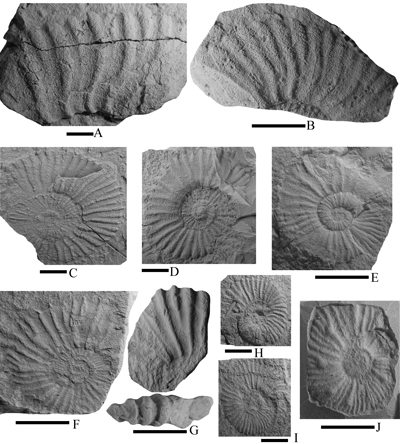
Click on thumbnail to enlarge the image.
Figure 1: A: Dufrenoyia sp. lateral view of the specimen IGM 292. B: Dufrenoyia sp. lateral view of the specimen IGM 300. C: Colombiceras sp. lateral view of the specimen IGM 301. D: Colombiceras spathi lateral view of the specimen IGM 307. E: Colombiceras spp. lateral view of the specimen IGM 305. F: Colombiceras spp. lateral view of the specimen IGM 298. G: Colombiceras spp. lateral and ventral views of the specimen IGM 304. H: Colombiceras spathi lateral view of the specimen IGM 306. I: Colombiceras mexicanus lateral view of the specimen IGM 303. J: Acanthohoplites aff. bigoureti lateral view of the cast of the specimen IGM 299. Scale bar is 10 mm.
Family Parahoplitidae Spath, 1922
Subfamily Acanthohoplitinae Stoyanow, 1949
Genus Colombiceras Spath, 1923
Colombiceras spathi Humphrey, 1949
(Figs. 1.D, 1.H ![]() & 2
& 2 ![]() - 3
- 3 ![]() - 4
- 4 ![]() )
)
|
v. p. |
Parahoplites cfr. Milletianus Pictet sp. non Orb., Burckhardt, p. 194, Pl. 43, fig. 4. |
|
|
v. p. |
Parahoplites sp. ind., Burckhardt, p. 195, Pl. 43, fig. 6. |
|
|
v. p. |
Parahoplites "several undetermined forms", Burckhardt, p. 23, Pl. 3, figs. 11-12, ?13. |
|
|
v. |
Colombiceras spathi Humphrey, p. 151, Pl. 18, figs. 7-8. |
|
|
Colombiceras spathi Humphrey, Cantú Chapa, Pl. 1, figs. 8-8.a. |
||
|
v. |
Colombiceras spathi Humphrey, Carreño et al., p. 198, Fig. 69.h (= Humphrey, 1949, Pl. 18, fig. 7). |
|
|
Colombiceras spathi Humphrey, Contreras y Montero et al., p. w.n. (=without number), Fig. w.n. |
||
|
"Parahoplites cf. milletianus" Pictet sp. non Orb., Contreras y Montero et al., p. w.n., Fig. w.n. (= Burckhardt, 1906, Pl. 43, fig. 4). |
||
|
v. |
Colombiceras spathi Humphrey, Barragán, p. 117, Pl. 57, figs. 3-10. |
|
|
v. |
Colombiceras spathi Humphrey, Barragán, p. 194, Fig. 4 (5). |
|
|
v. |
Colombiceras spathi Humphrey, Méndez-Franco, p. 69, Pl. 7, figs. 1-3. |
|
|
v. |
Colombiceras spathi Humphrey, Avila-Licona, p. 34, Pl. 2, fig. 3. |
|
|
v. |
Colombiceras spathi Humphrey, Barragán and Maurrasse, p. 152, Fig. 3.f. |
|
|
v. |
Colombiceras aff. spathi Humphrey, Moreno-Bedmar et al., Figs. 7.P & VII.G-I. |
Material:
Two specimens: IGM
306 Sierra south of Sierra de San José (Appendix: Geologic cartography Map
2 ![]() , blue
arrow number 1) and IGM 307, Puerto Arrieros camino de Santa Rosa (Appendix:
Geologic cartography Map
2
, blue
arrow number 1) and IGM 307, Puerto Arrieros camino de Santa Rosa (Appendix:
Geologic cartography Map
2 ![]() , blue arrow number 2).
, blue arrow number 2).
Description: The shell is
evolute. The ornamentation consists of irregularly alternating primary and
secondary ribs. Primary ribs rise on the umbilical wall and the secondary ribs
start at the middle to lower part of the flank. In the juvenile and sub-adult
stages, ribs are strongly spatulate and thicker than the interspaces (Fig.
2 ![]() ).
As the ammonites approach the adult stage, the interspaces become wider than the
ribs, which become less pronounced (Figs. 1.D
).
As the ammonites approach the adult stage, the interspaces become wider than the
ribs, which become less pronounced (Figs. 1.D ![]() & 2
& 2 ![]() - 3
- 3 ![]() - 4
- 4 ![]() ). In the specimen IGM
306 D is 25.8 mm and H is 10.1 mm. We count 20 ribs on the last half whorl. For
the other specimen, IGM 307, D is 39.5 mm and H is 15.1 mm. We count 18 ribs on
the last half whorl.
). In the specimen IGM
306 D is 25.8 mm and H is 10.1 mm. We count 20 ribs on the last half whorl. For
the other specimen, IGM 307, D is 39.5 mm and H is 15.1 mm. We count 18 ribs on
the last half whorl.
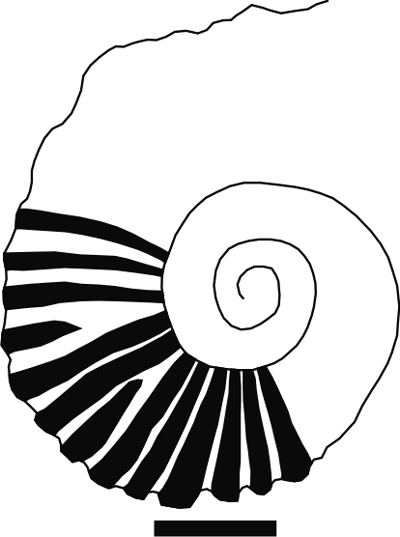
Click on thumbnail to enlarge the image.
Figure 2:
Schematic
drawing of the specimen IGM 307, see photography in Figure 1.D ![]() . Scale bar 10 mm.
. Scale bar 10 mm.
Discussion:
The two
specimens assigned to this taxon match very well with the morphology of the
holotype UMMP 24298 (Fig. 3 ![]() ). Burckhardt
(1925) described two specimens
of Colombiceras under the generic name
of Parahoplites. One of them,
illustrated in Figure 4
). Burckhardt
(1925) described two specimens
of Colombiceras under the generic name
of Parahoplites. One of them,
illustrated in Figure 4 ![]() , can be assigned without doubt to C.
spathi.
, can be assigned without doubt to C.
spathi.
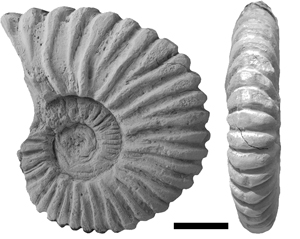
Click on thumbnail to enlarge the image.
Figure 3: Holotype of Colombiceras spathi UMMP 24298, La Peña Formation, Rincón de Los Potreritos, Sierra del Caporal, Coahuila State, northern Mexico. Newly photographed for this work. Scale bar 10 mm.
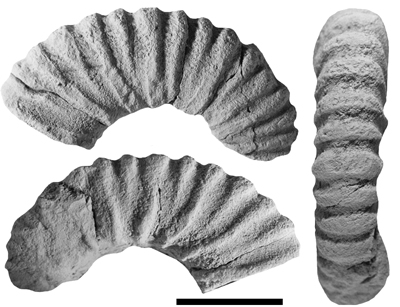
Click on thumbnail to enlarge the image.
Figure 4: Colombiceras spathi IGM 1879. Specimen described by Burckhardt (1925), Pl. 3, figs. 11-12, as belonging to the genus Parahoplites, La Peña Formation, Loma Verde, Río Nazas, Durango State, northern Mexico. Newly photographed for this work. Scale bar 10 mm.
Occurrence: The range of this species must be made more precise in future works. Our current knowledge allows assignment to an imprecise position between ammonite zones Dufrenoyia furcata and Caseyella aguilerae, which are uppermost lower Aptian and lowermost upper Aptian, respectively. However, Colombiceras spathi seems to be a primitive Colombiceras and probably is restricted to the Dufrenoyia justinae Zone.
Colombiceras mexicanus (Humphrey, 1949) n. comb.
|
v. p. |
Parahoplites cfr. Milletianus Pictet sp. non Orbigny, Burckhardt, p. 194, Pl. 43, fig. 10. |
|
|
v. |
Parahoplites mexicanus Humphrey, p. 137, Pl. 12, figs. 7-8. |
|
|
? |
Parahoplites mexicanus Humphrey, Contreras y Montero et al., p. w.n., Fig. w.n. |
|
|
v. |
Parahoplites mexicanus Humphrey, Barragán, p. 130, Pl. 59, figs. 1-11. |
|
|
v.? |
Parahoplites mexicanus Humphrey, Méndez-Franco, p. 83, Pl. 8, figs. 4-6. |
|
|
v.? |
Parahoplites mexicanus Humphrey, Avila-Licona, p. 46, Pl. 9, fig. 9. |
Material:
One specimen: IGM
303, Puerto Arrieros camino de Santa Rosa (Appendix: Geologic cartography Map
2 ![]() , blue
arrow number 2).
, blue
arrow number 2).
Description: The shell is evolute. The ornamentation consists of primary and secondary rectiradiate and non-spatulate thin ribs. The width of the ribs and interspaces is constant and similar. The secondary ribs are intercalated and/or bifurcated around the lower third of the flank. The costation density is high.
Discussion:
The specimens
originally identified by Burckhardt (1906a) as Parahoplites
cfr. Milletianus are reassigned in
this work to the species Colombiceras
mexicanus. A careful review of the holotype of this species (UMMP 22668) was
carried out to support this reassignment. The holotype (Fig. 5 ![]() )
is a well
preserved specimen that displays an evolute shell with a compressed whorl
section, flat flanks and a relatively flattened ventral region. When the
ammonite grows, the whorl section becomes rounded. These features correspond to
the genus Colombiceras. The genera Parahoplites
and Kazanskyella have a more involute
shell, with a less compressed oval whorl section. Colombiceras
mexicanus does not display spatulate ribs, a feature that usually identifies
the rest of species of the genus Colombiceras.
However, its ribs have more relief and are wider in the ventral region, which
are typical characteristics of the genus. In our opinion, specimens assigned to
the genus Parahoplites in America can
be reassigned, generally, to the endemic American genus Kazanskyella.
In the recent Bachelor thesis of Ovando-Figueroa (2016) the differences between
the genera Parahoplites and Kazanskyella
are discussed. It seems that the genus Parahoplites
is not present in America and previous assignations in several papers are due to
generic misidentifications, such as the current case where the species Parahoplites
mexicanus corresponds to Colombiceras
mexicanus.
)
is a well
preserved specimen that displays an evolute shell with a compressed whorl
section, flat flanks and a relatively flattened ventral region. When the
ammonite grows, the whorl section becomes rounded. These features correspond to
the genus Colombiceras. The genera Parahoplites
and Kazanskyella have a more involute
shell, with a less compressed oval whorl section. Colombiceras
mexicanus does not display spatulate ribs, a feature that usually identifies
the rest of species of the genus Colombiceras.
However, its ribs have more relief and are wider in the ventral region, which
are typical characteristics of the genus. In our opinion, specimens assigned to
the genus Parahoplites in America can
be reassigned, generally, to the endemic American genus Kazanskyella.
In the recent Bachelor thesis of Ovando-Figueroa (2016) the differences between
the genera Parahoplites and Kazanskyella
are discussed. It seems that the genus Parahoplites
is not present in America and previous assignations in several papers are due to
generic misidentifications, such as the current case where the species Parahoplites
mexicanus corresponds to Colombiceras
mexicanus.
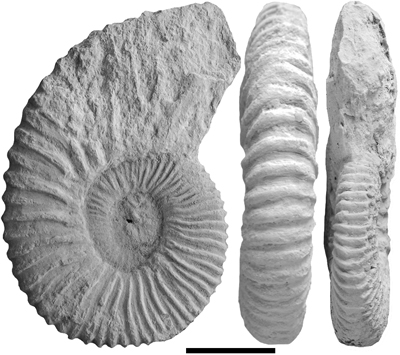
Click on thumbnail to enlarge the image.
Figure 5: Holotype of Colombiceras mexicanus UMMP 22668, La Peña Formation, Rincón de Los Potreritos, Sierra del Caporal, Coahuila State, northern Mexico. Newly photographed for this work. Scale bar 10 mm.
Occurrence: Upper Aptian, probably not the lowermost part. The record of the genus Colombiceras starts in the uppermost lower Aptian, Dufrenoyia justinae Zone, becoming more abundant during the upper Aptian. The first species of the genus in the stratigraphic record are clearly distinguished by their robust spatulate ribs. This morphological feature spans from the uppermost lower Aptian to the lowermost upper Aptian Caseyella aguilerae Zone. Upwards, above the lowermost upper Aptian, the ribs on the species of the genus become less- to non-spatulate, as in the case of the species Colombiceras mexicanus. In summary for this species, very likely, middle to upper part of Caseyella aguilerae Zone.
Colombiceras sp.
(Fig. 1.C ![]() )
)
|
v. p. |
Parahoplites cfr. Milletianus Pictet sp. non Orbigny, Burckhardt, p. 194, Pl. 43, fig. 5. |
|
|
Colombiceras cf. tobleri Sinzow, non Jacob, Contreras y Montero et al. p. w.n., Fig. w.n. |
Material:
One specimen: IGM
301, Sierra to the south of Cerro Colorado, Santa Rosa (Appendix: Geologic
cartography Map
2 ![]() , blue arrow number 3).
, blue arrow number 3).
Description: The shell is evolute. The ornamentation consists of a very regular alternating pattern of rectiradiate primary and secondary ribs. The interspaces are wider than the ribs. Additionally, in the inner whorls, some primary ribs display a tubercle at the middle of the flank, from which a bifurcated secondary rib arises. This characteristic is typical of the genus Colombiceras. The density of the ribs is lower than in Colombiceras mexicanus and is fairly constant throughout the whole coiling.
Discussion: This specimen presents a constant rib width. This characteristic stands out because species of Colombiceras usually have spatulate ribs. These features can be observed in the Mexican species Colombiceras mexicanus. However Colombiceras sp., described herein, presents a less dense ribbing and is similar to the specimen named as Colombiceras tobleri by Contreras y Montero et al. (1992) from Michoacán State, western Mexico. These authors used Sinzow's (1908) conception of C. tobleri, which is very close to Jacob and Tobler's (1906) proper conception of the taxon. Both conceptions of C. tobleri differ from the Mexican forms by presenting more robust and slightly spatulate ribs, especially in the inner whorls.
Occurrence: Upper Aptian, not the lowermost part, perhaps the middle-upper part of Caseyella aguilerae Zone.
Colombiceras spp.
|
v. p. |
Parahoplites sp., Burckhardt, p. 192, Pl. 42, figs. 9-10; Pl. 43, fig. 3. |
|
|
v. p. |
Parahoplites cf. Milletianus Pictet sp. non Orb., Burckhardt, p. 194, Pl. 43, figs. 8-9. |
Material:
Five specimens: IGM's 297, 298, 305, Puerto Arrieros camino de Santa Rosa, (Appendix: Geologic
cartography Map
2 ![]() , blue arrow number 2); IGM 304, Sierra de los Gallos Blancos (Appendix:
Geologic cartography Map
2
, blue arrow number 2); IGM 304, Sierra de los Gallos Blancos (Appendix:
Geologic cartography Map
2 ![]() , blue arrow number 4) and IGM 7175, Sierra south of Cerro
Colorado, Santa Rosa (Appendix: Geologic cartography Map
2
, blue arrow number 4) and IGM 7175, Sierra south of Cerro
Colorado, Santa Rosa (Appendix: Geologic cartography Map
2 ![]() , blue arrow number 3).
, blue arrow number 3).
Discussion:
Under Colombiceras
spp. we include what are probably several species of the genus Colombiceras. The specimens could not be studied in detail due to their juvenile
stage (Fig. 1.E-F ![]() ), or fragmentary condition
(Fig. 1.G
), or fragmentary condition
(Fig. 1.G ![]() ). The generic attribution
of these five specimens to the genus Colombiceras
is clear. The characteristic tubercles in some primary ribs and the bifurcation
of secondary ribs can be observed in some juvenile specimens (see Fig. 1.E-F
). The generic attribution
of these five specimens to the genus Colombiceras
is clear. The characteristic tubercles in some primary ribs and the bifurcation
of secondary ribs can be observed in some juvenile specimens (see Fig. 1.E-F ![]() ).
In other specimens, features such as the typical spatulate form of the ribs, as
well as ribs with more relief that become wider in the ventral region, can be
appreciated (Fig. 1.G1
).
In other specimens, features such as the typical spatulate form of the ribs, as
well as ribs with more relief that become wider in the ventral region, can be
appreciated (Fig. 1.G1 ![]() ).
).
Occurrence: Uppermost lower Aptian - upper Aptian. A more precise age-assignment is difficult to infer due to the impossibility of identifing the species.
Genus Acanthohoplites Sinzow, 1907
Acanthohoplites aff. bigoureti (Seunes, 1887)
|
Acanthoceras Bigoureti Seunes p. 566, Pl. 14, figs. 3-4.a-b. |
||
|
Parahoplites Bigoureti Seunes, Anthula, p. 117 (63), Pl. 13 (12), fig. 2.a-c. |
||
|
Parahoplites Bigoureti Seunes, Liebus, p. 115, Pl. 6, fig. 2. |
||
|
? |
Douvilleiceras Bigoureti Seunes, Jacob, p. 415, Fig. 7; Pl. 13, fig. 6.a-b. |
|
|
? |
Douvilleiceras Bigoureti Seunesi, Jacob, p. 416, Pl. 13, figs. 7.a-b. |
|
|
Parahoplites sp. ind., Burckhardt, p. 192, Pl. 43, fig. 1. |
||
|
Douvilleiceras bigoureti Seunes, Pervinquière, p. 195, Fig. 75; Pl. 7, fig. 37.a-b & 38.a-b. |
||
|
Douvilleiceras Bigoureti Seunes, Collet, p. 526, Fig. 10. |
||
|
Acanthohoplites Bigoureti Seunes, Sinzow, p. 488, Pl. 6, figs. 4, 4.a, 5, 5.a & 6. |
||
|
? |
Acanthohoplites Bigoureti Seunes, Sinzow, p. 111, Pl. 6, fig. 3. |
|
|
Acanthoplites bigoureti Seunes, Besairie, p. 153, Pl. 15, figs. 1-2 & 9. |
||
|
? |
Acanthoplites bigoureti Seunes, Riedel, p. 45, Pl. 8, fig. 7; Pl. 14, fig. 24. |
|
|
? |
Acanthohoplites bigoureti Seunes, Eristavi, p. 101, Pl. 4, fig. 1. |
|
|
? |
Acanthohoplites bigoureti v. seunesi Jacob, Eristavi, p. 101, Pl. 4, fig. 3. |
|
|
Acanthohoplites bigoureti Seunes, Drushchits and Kudryavtsev, p. 321, Pl. 8, figs. 1.a, 1.б, 2.a & 2.б. |
||
|
Cheloniceras bigoureti Seunes, Eristavi, p. 58, Pl. 4, fig. 1. |
||
|
Acanthohoplites bigoureti (Seunes), Luppov, p. 182, Fig. 5; Pl. 1, figs. 4.a, 4.б, 4.в, 5.a & 5.б. |
||
|
Acanthoplites bigoureti Seunes var. analavelonensis Collignon, p. 47, Pl. 234, figs. 1000-1004. |
||
|
Acanthohoplites (?) bigoureti Seunes, Egoian, p. 127, Pl. 5, figs. 2.a, 2.б, 2.в, 3.a, 3.б & 3.в. |
||
|
Acanthohoplites aff. bigoureti Seunes, Cantú Chapa, p. 9, Pl. 2, fig. 2. |
||
|
Acanthohoplites (?) bigoureti Seunes, Egoian, p. 162, Pl. 23, fig. 33. |
||
|
? |
Acanthohoplites bigoureti (Seunes), Kvantaliani, p. 42, Fig. 22.a, 22.б, 22.в & 22.ѕ; Pl. 4, fig. 3.a, 3.б & 3.в. |
|
|
Acanthohoplites bigoureti luppowi (Seunes), Kvantaliani, p. 45, Figs. 23.a, 23.б, 23.в, 23.г, 23.д & 24; Pl. 4, fig. 4.a, 4.б & 4.в; Pl. 5, fig. 5.a, 5.б & 5.в. |
||
|
? |
Hypacanthoplites aff. bigoureti (Seunes), Kemper, Pl. 24, fig. 2.a-b. |
|
|
Acanthohoplites aff. bigoureti (Seunes), Destombes et al., p. 63, Pl. 3, fig. 5. |
||
|
"Acanthohoplites" aff. seunesi (Jacob), Destombes et al., p. 65, Fig. 5.1; Pl. 3, figs. 6.a-b. |
||
|
? |
Hypacanthoplites aff. bigoureti (Seunes), Kemper, Pl. 3, figs. 2.a-b, 3.a-b, 4.a-b & 5-6. |
|
|
Acanthohoplites bigoureti (Seunes), Förster, p. 205, Pl. 9, fig. 4.a-b. |
||
|
Hypacanthoplites bigoureti (Seunes), Seyed-Emami, p. 726, Pl. 3, figs. 7.a-c & 11.a-c. |
||
|
Acanthohoplites bigoureti (Seunes), Thomel, p. 132, Figs. 261-262. |
||
|
? |
Acanthohoplites cf. bigoureti Seunes, Leshchukh, p. 129, Pl. 10, figs. 6-7. |
|
|
Acanthohoplites ex. gr. bigoureti (Seunes), Michalik and Vaiček, p. 570, Pl. 1, fig. 5. |
||
|
Acanthohoplites aff. bigoureti (Seunes), Immel, p. 123, Pl. 13, fig. 5. |
||
|
? |
Acanthohoplites bigoureti Seunes, Leshchukh, p. 118, Pl. 13, fig. 8. |
|
|
? |
Acanthohoplites bigoureti bigoureti (Seunes), Ivanov and Stoykova, Pl. 2, fig. 1. |
|
|
Acanthohoplites aff. bigoureti Seunes, Contreras y Montero et al., p. w.n., fig. w.n. (= Cantú Chapa, 1968, Pl. 2, fig. 2). |
||
|
Acanthoplites bigoureti (Seunes), Maréchal, p. 85, Pl. 2, fig. 8.a-b. |
||
|
? |
Acanthoplites cf. bigoureti Sinzow non Seunes, Avram et al., p. 16, Pl. 3, fig. 18. |
|
|
Acanthohoplites bigoureti bigoureti Seunes, Kotetishvili et al., p. 399, Pl. 102, figs. 3.a, 3.б & 3.в (= Kvantaliani, 1971, Pl. 4, fig. 3.a, 3.б & 3.в). |
||
|
v. non |
Acanthoplites bigoureti (Seunes), Moreno, p. 98, Pl. 8, figs. 9-10. |
|
|
non |
Acanthohoplites bigoureti (Seunes), Raisossadat, p. 915, fig. 5.A-B. |
|
|
Acanthohoplites bigoureti (Seunes), Szives, p. 68, Pl. 9, fig. 5.a-b; Pl. 10, figs. 1 & 7. |
||
|
Protacanthoplites gr. bigoureti Seunes, Moreno-Bedmar et al., p. 156, in Fig. 1. |
Material:
One specimen: IGM
299 from Puerto Arrieros camino de Santa Rosa (Appendix: Geologic cartography Map
2 ![]() ,
blue arrow number 2) preserved as an external mould.
,
blue arrow number 2) preserved as an external mould.
Description:
The shell is
evolute. The ornamentation consists of an irregular pattern of alternating ribs.
Primary ribs rise on the umbilical wall and display large tubercles around the
middle of the flank. Primary ribs trifurcate from those tubercles (Fig.
6 ![]() ).
Secondary ribs can also appear in the umbilical wall or in the lower third of
the flank.
).
Secondary ribs can also appear in the umbilical wall or in the lower third of
the flank.
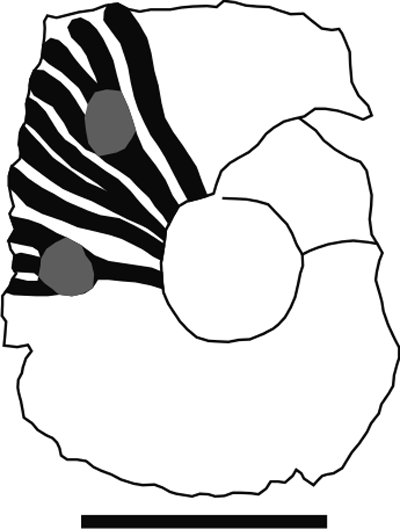
Click on thumbnail to enlarge the image.
Figure
6:
Partial and
schematic drawing of the cast of the specimen IGM 299, see photography in Figure
1.J ![]() . Scale bar 10 mm.
. Scale bar 10 mm.
Discussion: The trifurcate primary ribs from large tubercles are characteristic of the species Acanthohoplites bigoureti (Seunes). Nonetheless, the majority of the species of the genus display a pattern of bifurcating ribs just as in the genus Colombiceras. However, their primary ribs are more robust and the tubercles are larger than in the latter species. Some species of Acanthohoplites present two tubercles in their primary ribs. The conspicuous feature of trifurcation usually is related to the species Acanthohoplites bigoureti (Seunes). However, several of the illustrated specimens of this taxon display a bifurcation pattern. The better examples of trifurcated forms of Acanthohoplites bigoureti (Seunes) are illustrated by Egoian (1965) and Moreno-Bedmar et al. (2008). In Mexico there are numerous citations and illustrations of some specimens assigned to the genus Acanthohoplites, but in our opinion the majority of them correspond to specimens of the genus Colombiceras. The best example of a clear report of the genus Acanthohoplites in Mexico is from Michoacán State, western Mexico, which was shown by Cantú Chapa in 1968 as Acanthohoplites aff. bigoureti. Later, the same specimen was described by Contreras y Montero et al. in 1992. The specimen illustrated herein is very similar to that showed by Cantú Chapa (1968) and shows great affinity to Acanthohoplites bigoureti. However, its fragmentary condition forces us to leave the Mexican specimen with an open name as an affinis.
Occurrence: Upper part of the upper Aptian, clearly this ammonite must be younger than the Caseyella aguilerae Zone.
The current work allows the reassignment of the original identifications of Burckhardt (1906a) to Dufrenoyia sp., Colombiceras spathi Humphrey, Colombiceras mexicanus (Humphrey) n. comb., Colombiceras sp., Colombiceras spp. and Acanthohoplites aff. bigoureti (Seunes).
Reports of the genus Parahoplites in America seem to be due to the generic misidentifications. In the current work, one of these assignations must be reassigned to the genus Colombiceras that constitutes a new combination for Colombiceras mexicanus (Humphrey).
The ammonite fauna collected by Burckhardt is the only reported occurrence of Aptian ammonoids from Zacatecas State, prompting us to reexplore Burckhardt's localities in the future to conduct a systematic bed-by-bed sampling of one or several stratigraphic sections if appropriate outcrops can be found. One of these localities, Puerto Arrieros camino de Santa Rosa, seems particularly interesting due to the presence of the genus Acanthohoplites which is quite rare in Mexico and in consequence scarcely known.
We appreciate the help of Dra. María del Carmen Perrilliat Montoya and M. en C. Violeta Romero Mayén for providing access to the Mexican ammonites of this study, which are housed in the Museo María del Carmen Perrilliat M., Colección Nacional de Paleontología, Instituto de Geología, UNAM, México D.F. We appreciate the assistance and access to facilities to review the Mexican Aptian ammonites of the Humphrey's collection by Dr. Daniel Miller, Coordinator of the Invertebrate Collection of the Museum of Paleontology, and Dr. William Sanders, preparator of the Vertebrate Fossil Preparation Laboratory, both from the University of Michigan, Ann Arbor, Michigan, USA. We are very grateful for the helpful corrections and suggestions made by Gérard Delanoy, Emmanuel Robert, Yves Dutour and the editor Michel Moullade. We are very grateful to the Language Editor, Phil Salvador, for his corrections.
Anthula D.J. (1900).- Über die Kreidefossilien des Kaukasus mit einem allgemeinen Ueberblick über die entwicklung der Sedimentärbildungen des Kaukasus.- Beiträge zur Paläeontologie und Geologie Öesterreich-Ungarns und des Orients, Wien, vol. 12 (1899), p. 55-160 (1-106).
Avila Licona J.A. (2005, unpublished).- Análisis bioestratigráfico basado en fauna de ammonites del Aptiano (Cretácico Inferior) del área del Cañon de la Boca, Nuevo León.- Bachelor Thesis, México D.F., Mexico, Universidad Nacional Autónoma de México, Facultad de Ciencias, 68 p.
Avram E., Bordea S., Cociuba I., Huza R. & Preda I. (2001).- Ammonite assemblages of the Ecleja Formation (Northern Apuseni Mts., Romania).- Romanian Journal of Stratigraphy, Bucharest, vol. 79, p. 13-20.
Barragán R. (2000, unpublished).- Ammonite biostratigraphy, lithofacies variations, and paleoceanographic implications for Barremian-Aptian sequences of northeastern Mexico.- Ph.D. Thesis, Department of Geology, Florida International University, Miami, 296 p.
Barragán R. (2001).- Sedimentological and paleoecological aspects of the Aptian transgressive event of Sierra del Rosario, Durango, northeast Mexico.- Journal of South American Earth Sciences, Amsterdam, vol. 14, no. 2, p. 189-202.
Barragán R. & Maurrasse F.J-M.R. (2008).- Lower Aptian (Lower Cretaceous) ammonites from the basal strata of the La Peña Formation of Nuevo León State, northeast Mexico: Biochronostratigraphic implications.- Revista Mexicana de Ciencias Geológicas, Mexico, vol. 25, no. 1, p. 145-157.
Besairie H. (1936).- Recherches géologiques à Madagascar. 1. La géologie du Nord-Ouest.- Mémoires de l'Académie Malgache, Tananarive, vol. 21, 259 p.
Burckhardt C. (1906a).- La faune Jurassique de Mazapil avec un appendice sur les fossiles du Crétacique inférieur.- Boletín del Instituto de Geología de México, México D.F., vol. 23, p. 1-217.
Burckhardt C. (1906b).- Géologie de la Sierra de Mazapil et Santa Rosa.- Excursión 16, Dixième Congrès Géologique International, Guide des Excursions, Mexico City, Imprenta Ministerio de Fomento, 40 p. (2 geological maps, 1 sheet with 13 geologic profiles, 14 Pls.).
Burckhardt C. (1925).- Faunas del Aptiano de Nazas (Durango).- Boletín del Instituto de Geología de México, México D.F., vol. 45, p. 1-71.
Cantú Chapa C.M. (1968).- Las Rocas Eocretáceas de Zitácuaro, Michoacán.- Instituto Mexicano del Petróleo, México D.F., (sección Geología), Monografía 2, p. 3-18.
Cantú Chapa C.M. (1976).- Estratigrafía de la Formación La Peña (Aptiano Sup.) en el área de Monterrey, N.L.- Revista del Instituto Mexicano del Petróleo, México D.F., vol. 8, no. 4, p. 7-16.
Carreño A.L., Perrilliat M.C., González-Arreola C., Applegate S.P., Carranza-Castañeda O. & Martínez-Hernández E. (1989).- Fósiles Tipo Mexicanos.- Volumen comemorativo del centenario del Instituto de Geología (1886-1996), Universidad Nacional Autónoma de México, México D.F., 531 p.
Collet L.W. (1907).- Sur quelques espèces de l'Albien inférieur de Vöhrum (Hanovre).- Mémoires de la Société de Physique et d'Histoire Naturelle de Genève, Genève, vol. 35, no. 3, p. 519-529.
Collignon M. (1962).- Atlas des fossiles caractéristiques de Madagascar (Ammonites) Fascicule 9 (Aptien).- Service Géologique, Tananarive, 64 p.
Contreras y Montero B., Gómez Luna M.E., Martínez Cortes A. & González Casildo V. (1992).- Catálogo de las amonitas de México, Parte III Cretácico Inferior (Barremiano-Aptiano) CAO-1404.- Instituto Mexicano del Petróleo, Subdirección de Tecnología de Exploración, Mexico, unnumbered pages.
Destombes P., Juignet P. & Rioult M. (1974).- Ammonites de l'Aptien-Albien du Bec de Caux, Normandie (NW France).- Bulletin de la Société géologique de Normandie et Amis du Muséum du Havre, vol. 61 (1973), p. 49-106.
Drushchits V.V. & Kudryavtsev M.P. (1960).- Atlas of the Lower Cretaceous fauna of the northern Caucasus and the Crimea.- Vsesoiuznyi Nauchno-Issledovatel'skii Institut Prirodnykh Gasov, Moscow, 701 p. [in Russian].
Egoian V.L. (1965).- Some ammonites of Clansayesian deposits of the western Caucasus.- Trudy Krasnodarskogo Filiala Vsesoiuznogo Neftegazovogo Nauchno-Issledovatel'skogo Instituta, Moscow, vol. 16, p. 112-160 [in Russian].
Egoian V.L. (1969).- Ammonites from the Clansayesian beds of the Western Caucasus.- Trudy Krasnodarsgogo Filiala Vsesojuznogo Neftegazovogo Nauchno-Issledovatel'skogo Instituta, Moscow, vol. 19, p. 126-188 [in Russian].
Eristavi M.C. (1955).- Lower Cretaceous fauna of Georgia.- Akademii Nauk Gruzinskoi SSR. Monograph, Moscow, vol. 6, 225 p. [in Russian].
Eristavi M.C. (1961).- Aptian and Albian ammonites of the Northern Caucasus.- Trudy Geologicheskogo Instituta Akademii Nauk Gruzinskaia SSSR, Moscow, vol. 12, p. 41-77 [in Russian].
Förster R. (1975).- Die geologische Entwicklung von Süd-Mozambique seit der Unterkreide und die Ammoniten-Fauna von Unterkreide und Cenoman.- Geologisches Jahrbuch, Hannover, (Reihe B), Heft 12, 324 p.
Humphrey W.E. (1949).- Geology of Sierra de Los Muertos area, Mexico (with descriptions of Aptian cephalopods from the La Peña Formation).- Geological Society of America Bulletin, Tulsa, vol. 60, p. 89-176.
Immel H. (1987).- Die Kreideammoniten der nördlichen Kalkalpen.- Zitteliana, München, vol. 15, p. 3-163.
Ivanov M. & Stoykova K. (1990).- Aptian and Albian stratigraphy of the Ruse in the central Moesian Platform.- Geologica Balcanica, Sofia, vol. 20, no. 5, p. 45-71 [in Bulgarian].
Jacob C. (1905).- Étude sur les ammonites et sur l'horizon stratigraphique du gisement de Clansayes.- Bulletin de la Société géologique de France, Paris, (4° sér.) vol. 5, p. 399-432.
Jacob C. & Tobler A. (1906).- Étude stratigraphique et paléontologique du Gault de la vallée Engelberger Aa (Alpes calcaires suisses, environs du Lac des Quatre Cantons).- Mémoire de la Société paléontologique de Suisse, Genève, vol. 33, p. 3-26.
Kemper E. (1971).- Zur Gliederung und Abgrenzung des norddeutschen Aptium mit Ammoniten.- Geologisches Jahrbuch, Hannover, Band 89, p. 359-390.
Kemper E. (1975).- Die Cephalopoden aus dem Unter-Alb (Zone der Leymeriella tardefurcata) von Altwarmbüchen.- Berichte der Naturhistorichen Gesellschaft, Hannover, vol. 119, p. 87-111.
Kilian W. & Reboul P. (1915).- Contribution à l'étude des faunes paléocrétacés du Sud-Est de la France. I. La faune de l'Aptien inférieur des environs de Montélimar (Carrière de l'Homme d'Armes, Drôme). II. Sur quelques ammonites de l'Hauterivien de la Bégude (Basses Alpes).- Mémoires pour servir à l'Explication de la Carte géologique détaillée de la France, Paris, no. 14, 288 p.
Kotetishvili E., Kvantaliani I.V., Kakabadze M.V. & Tsirekidze L.R. (eds., 2005).- Atlas of Early Cretaceous fauna of Georgia.- Proceedings of the Georgian Academy of Sciences, A. Janelidze Geological Institute, Tbilisi, (n. ser.), vol. 120, 788 p.
Kvantaliani I.V. (1971).- The Aptian ammonites of Abkhazia.- Georgian Polytechnical Institute, Tbilisi, 175 p. [in Russian with English summary].
Leshchukh R.J. (1982).- Lower Cretaceous ammonites of the Ukrainian Carpathians.- Naukovya Dumka, Kiev, 163 p. [in Ukrainian].
Leshchukh R.J. (1987).- Lower Cretaceous fauna of the Crimean plain and the northern Pre-Chernomor.- Naukovya Dumka, Kiev, 220 p. [in Ukrainian].
Liebus A. (1902).- Über einige Fossilien aus der Karpathischen Kreide, mit stratigraphischen Bemerkungen von V. Uhlig.- Beiträge zur Paläontologie und Geologie Österreich-Ungarns und des Orients, Wien, Band XIV, Heft I/II, p. 113-130 (1-18).
Luppov N.P. (1961).- Ammonites from the Lower Cretaceous deposits of the southwest spurs of Hissar Range.- Vsesojuznyi Nauchno-Issledovatel'skii, Otdel Geologicheskogo Instituta, Moscow, vol. 46, no. 2, p. 175-218 [in Russian].
Maréchal M. (1994).- Les Hypacanthoplites Spath, 1923 des Argiles à Bucaillella cayeuxi de Cauville (76) et leur position stratigraphique.- Bulletin trimestriel de la Société géologique de Normandie et des Amis du Muséum du Havre, Havre, vol. 81, no. 2, p. 83-96.
Méndez Franco A.L. (2003, unpublished).- Bioestratigrafía de ammonites y variaciones de litofacies en una secuencia estratigráfica del Barremiano-Aptiano (Cretácico Inferior) del área del Cañon de La Huasteca, Estado de Nuevo León.- Bachelor Thesis, México D.F., Universidad Nacional Autónoma de México, Facultad de Ciencias. 179 p.
Michalik J. & Vaiček Z. (1984).- To the early Mid Cretaceous West Carpathian development: The age and environmental position of the "Skalica Breccia".- Geologický Zborník Geologica Carpathica, Bratislava, vol. 35, no. 5, p. 559-581.
Moreno J.A. (2005, unpublished).- Estudio bioestratigráfico del Aptiense del Macizo del Garraf (Cadena Costero Catalana).- Bachelor Thesis, Universitat de Barcelona, 130 p.
Moreno-Bedmar J.A., Bulot L.G., Company M., Sandoval J. & Tavera J.M. (2008).- Estudio bioestratigráfico de los ammonites del Aptiense medio de la sección de Aigües (Prebético alicantino, SE de España). Datos preliminares. In: Ruiz-Omeñaca J.I., Piñuela L. & García-Ramos J.C. (eds.), Libro de resúmenes.- XXIV Jornadas de la Sociedad Española de Paleontología. Museo del Jurásico de Asturias (MUJA), Colunga, 2008, p. 156-157.
Moreno-Bedmar J.A., Bover-Arnal T., Barragán R. & Salas R. (2012a).- Uppermost Lower Aptian transgressive records in Mexico and Spain: Chronostratigraphic implications for the Tethyan sequences.- Terra Nova, vol. 24, p. 333-338.
Moreno-Bedmar J.A., Company M., Sandoval J., Tavera J.M., Bover-Arnal T., Salas R., Delanoy G., Maurrasse F.J.-M.R. & Martínez R. (2012b).- Lower Aptian ammonite and carbon isotope stratigraphy in the eastern Prebetic Domain (Betic Cordillera, southeastern Spain).- Geologica Acta, Barcelona, vol. 10, no. 4, p. 333-350.
Moreno-Bedmar J.A., Barragán Manzo R., Company Sempere M. & Bulot L.G. (2013).- Aptian (lower Cretaceous) ammonite biostratigraphy of the Francisco Zarco Dam stratigraphic section (Durango State, northeast Mexico).- Journal of South American Earth Sciences, vol. 42, p. 150-158.
Ovando-Figueroa J.R. (2016, unpublished).- Ammonites del Aptiano superior-Albiano inferior (Cretácico Inferior) de la sección de Cerro Chino del estado de Chihuahua, noroeste de México.- Bachelor thesis, México D.F., Universidad Nacional Autónoma de México, Facultad de Estudios Superiores Iztacala, 98 p.
Pervinquière L. (1907).- Étude de paléontologie tunisienne - 1. Céphalopodes des terrains secondaires; système crétacique.- Mémoire de la Carte géologique de Tunisie, Paris, 438 p.
Raisossadat S.N. (2006).- The ammonite family Parahoplitidae in the Sanganeh Formation of the Kopet Dagh Basin, north-eastern Iran.- Cretaceous Research, London, vol. 27, p. 907-922.
Riedel L. (1938).- Amonitas del cretácico inferior de la Cordillera Oriental.- Estudios Geológicos y Paleontológicos sobre la Cordillera Oriental de Colombia, Parte 2, Ministerio de Industria y Trabajo, Departmento de Minas y Petróleos, Bogotá, p. 7-78.
Seunes J. (1887).- Sur quelques ammonites du Gault.- Bulletin de la Société géologique de France, Paris, (3e série), vol. 15, p. 557-571.
Seyed-Emami K. (1980).- Parahoplitidae (Ammonoidea) aus dem Nordost- und Zentraliran.- Neues Jahrbuch für Geologie und Paläontologie Monatshefte, Stuttgart, vol. 12, p. 719-737.
Sinzow I.T. (1908).- Untersuchung einiger Ammonitiden aus dem Unteren Gault Mangyschlaks und des Kaukasus.- Zapiski Imperatorskogo S.-Peterburgskogo Mineralogicheskogo Obshchestva, (series 2), vol. 45 (1907), p. 455-519.
Sinzow I.T. (1913).- Beiträge zur Kenntnis der unteren Kreideablagerungen des Nord-Kaukasus.- Travaux du Musée géologique Pierre le Grand près l'Academie Impériale des Sciences de St. Pétersbourg, vol. 7, p. 93-117.
Szives O., Csontos L., Bujtor L. & Fozy I. (2007).- Aptian-Campanian ammonites of Hungary.- Geologica Hungarica, Budapest, (Series Palaeontologica), vol. 57, p. 1-187.
Thomel G. (1980).- Ammonites.- Serre Édit., Nice, 227 p.

Click on thumbnail to enlarge the image.
Map 1: Location map, adapted from Burckhardt's geological map (1906b).
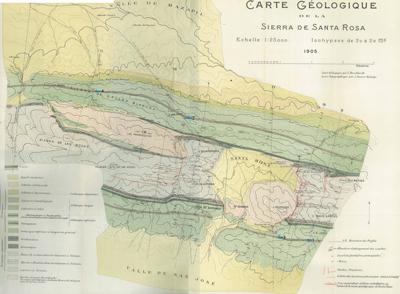
Click on thumbnail to enlarge the image.
Map 2: Location map, adapted from Burckhardt's geological map (1906b).